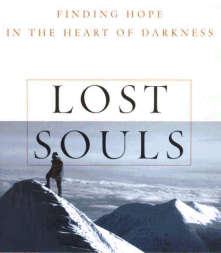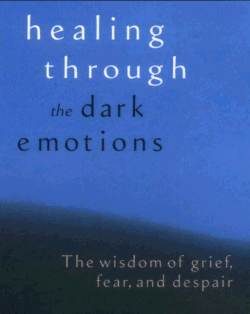 In contrast, there seems to be a Biblical story for every emotional ailment in Rabbi Niles Goldstein’s Lost Souls: Finding Hope in the Heart of Darkness. Its eight chapters seem intended as a typology of negative emotion, with titles like Panic, Disorientation, and Loneliness. Within each is a hodgepodge of erudite quotes (Sam Shepard, Bruno Schultz), pastoral stories, and homily. Although Goldstein occasionally dispenses advice, most of the time he prefers to recall Biblical figures who experienced the emotion under consideration, and draw lessons from their narratives.
In contrast, there seems to be a Biblical story for every emotional ailment in Rabbi Niles Goldstein’s Lost Souls: Finding Hope in the Heart of Darkness. Its eight chapters seem intended as a typology of negative emotion, with titles like Panic, Disorientation, and Loneliness. Within each is a hodgepodge of erudite quotes (Sam Shepard, Bruno Schultz), pastoral stories, and homily. Although Goldstein occasionally dispenses advice, most of the time he prefers to recall Biblical figures who experienced the emotion under consideration, and draw lessons from their narratives.
There’s something insufficient about each of these three components. Goldstein’s epigrammatic quotes are all very well-chosen, but even the use of “one-liners” in the context of negative emotion I find distressing. When real sadness hits, it penetrates to a level deeper than that of bumper-sticker spirituality. It’s fine to quote Hemingway, but he speaks from a deeper philosophy of suffering (one which I do not share), and it is that substratum, rather than the epigram, which contains the real teaching.
Second, the anecdotes in Lost Souls, and in Healing through Dark Emotions were often either inane or infuriating. First, I find an inherent absurdity in juxtaposing Cain and Abel, David and Uriah, with modern-day problems of drug addiction and cancer diagnoses. It is not that the modern problems are trivial -- Goldstein’s unfortunate sources include women (his stories are disproportionately about women) shot in a robbery, caring for dying parents, and nearly suffering miscarriages. It seems, rather, that there is a careless mixing of consciousness in leaping from Ancient Judea to contemporary New York. Do we really know how Abraham experienced loneliness? Does it even make sense to ask? When myth works, it does so on a level that seems deeper than ordinary psychology.
 Relatedly, and this flaw is particularly present in Greenspan’s book, there is a therapeutic progression that makes these profound stories seem almost pat. They are condensed into homily, and flattened as a result. Of course, both Greenspan and Goldstein acknowledge that the process is difficult along the way. But the way the stories are edited and presented, they resolve quickly, with an all-too-definite linearity. Greenspan’s “emotional alchemy” often reads like a sort of magic trick: “The quickest way to change what you feel is to change what you do,” she says at one point. Well, that may be good therapeutic advice, but is it that simple? Moreover, is it even desirable to “change what you feel” in this way?
Relatedly, and this flaw is particularly present in Greenspan’s book, there is a therapeutic progression that makes these profound stories seem almost pat. They are condensed into homily, and flattened as a result. Of course, both Greenspan and Goldstein acknowledge that the process is difficult along the way. But the way the stories are edited and presented, they resolve quickly, with an all-too-definite linearity. Greenspan’s “emotional alchemy” often reads like a sort of magic trick: “The quickest way to change what you feel is to change what you do,” she says at one point. Well, that may be good therapeutic advice, but is it that simple? Moreover, is it even desirable to “change what you feel” in this way?
I have a suspicion that many of those who are involved in changing what they feel are always involved in the process of doing so. In practice, it’s less a transformation from black to white and more a checkerboard of highs and lows that are, in some sense, constant. Clearly this is not true for the responses to unique, life-changing traumas. But I suspect it is true for the day-to-day “grief, fear, and despair” that haunts the people who buy these books. And if that is true, I wonder whether the checkerboard is really the healthiest, most honest way of dealing with negative emotions. Maybe it might be better to experience these emotions, learn from them, and not expect them either to be a net benefit, or the dross that one can so easily spin into gold.
To be fair to Greenspan, her book is itself a reply to two responses that are far, far worse. One is the “get a grip” mentality that says that any loss of control is a loss of dignity. The other is contemporary America’s turn to medication. Like soma in Aldous Huxley’s Brave New World, antidepressants are consumed by millions of people who are not depressed, but merely experiencing the normal ebb and flow of human feeling. “Emotional suffering,” Greenspan writes, “is not a sign of mental disorder or illness. It’s a universal fact of life... and a unique pathway of spiritual awakening, growth, and transformation.”
What Greenspan offers, in place of these denials of sadness, is advice to “attend to, befriend, and surrender to the energies of grief, despair, and fear.” So far, so good. But what troubled me was her almost formulaic “alchemy by which grief, despair, and fear are trasnmuted to gratitude, faith, and joy.”
Greenspan has gone exactly half the distance. She has rejected our society’s infantile fear of negative emotion, only to replicate it on a more sophisticated level. Why do we suppose that emotion must be changed in order for us to be happy? Can we not be happy and sad at the same time?
This is certainly my experience: writing this review just before heading out on retreat, just before volunteering in Florida, just before an election, I am in a period of intense anxiety and work. I’m not sleeping enough. I’m worried. I’m sure I’m missing something, somewhere, or that I could have acted more skillfully with regard to my election work. Yet with practice, I have learned to accommodate all of these unpleasant, neurotic, and irritating emotions. It’s nothing special: I just take a breath, draw my attention to my body, and remember who I am and why I seem to be here; I relax; and those concerns are put into perspective, as the quite understandable, quite Aok” worries of one human being, a beautiful mote of dust, a dream in the mind of God.
The bad feelings have not gone away. I can go visit them, if I really want to, because they have not changed into anything else. But more importantly, I’ve stopped feeling quite so bad about feeling bad, and that is most of the battle.



Straight Eye for the Consumer Guy
Dan Friedman
I'll Say Goodbye and Let you Go
Abigail Pickus
Three Jewish Books on Sadness
Jay Michaelson
Sufganiyot
Rachel Barenblat
The Other Jews: Secularism, Kabbalah and Radical Poetics
Hila Ratzabi
A Jewish Masterpiece
David Zellnik
Archive
Our 580 Back Pages
Zeek in Print
Fall/Winter 2004 issue now on sale
About Zeek
Mailing List
Contact Us
Subscribe
Tech Support
Links
From previous issues:
Two Prayers for the Days of Awe
Rabbi Zalman Schachter-Shalomi
Faces of Death
Thomas Vinciguerra
Hasidism and Homoeroticism
Jay Michaelson